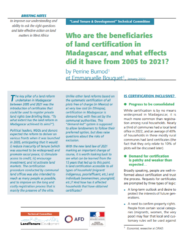
The key pillar of a land reform undertaken in Madagascar between 2005 and 2021 was the introduction of certificates that could be used to register private land rights (see Briefing Note, “To what extent has the land reform in Madagascar achieved its aims?”). Political leaders, NGOs and donors expected the reform to deliver on various fronts when it was launched in 2005, anticipating that it would: i) reduce insecurity of tenure (which was assumed to be widespread) and promote social peace; ii) stimulate access to credit; iii) encourage investment; and iv) activate land markets. The certification procedure conducted by communal land offices was also intended to reach as many people as possible, and to improve on the long and costly registration process that is mainly the preserve of the elite. Unlike other land reforms based on the systematic certification of all plots free of charge (in Mexico) or at very low cost (in Ethiopia), certification in Madagascar is demand-led, with fees set by the communal authorities. This “demand-led” system is supposed to allow landowners to follow their preferred option, but does raise questions about the risks of exclusion.
With the new land law of 2021 marking an important change of course, it is worth looking back to see what can be learned from the 15 years that led up to this point. Is land certification accessible to all types of household (migrant/indigenous, poor/affluent, etc.) and individuals (women/men, young/old, etc.)? Andhow has it affected households that have obtained certificates?
